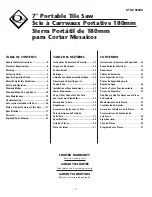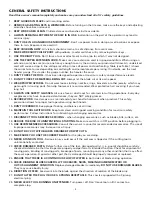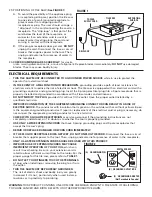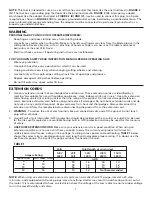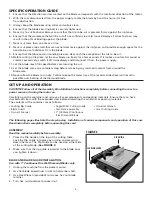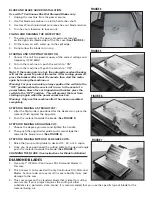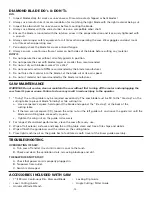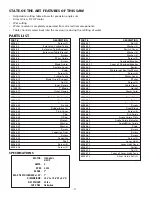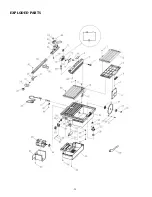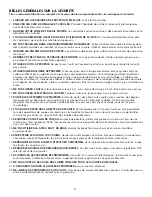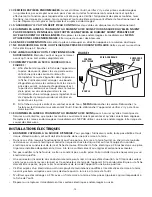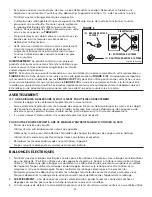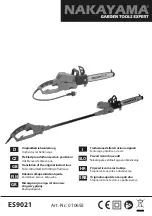
29. POSITIONING OF TILE SAW (
See FIGURE 1
)
A. To avoid the possibility of the appliance plug
or receptacle getting wet, position the tile saw
to one side of a wall-mounted receptacle to
prevent water from dripping onto the
receptacle or plug. The user should arrange a
“drip loop” in the cord connecting the saw to a
receptacle. The “drip loop” is that part of the
cord below the level of the receptacle, or
connector if an extension cord is used, to
prevent water traveling along the cord and
coming in contact with the receptacle.
B.
If the plug or receptacle does get wet,
DO NOT
unplug the cord. Disconnect the fuse or circuit
breaker that supplies power to the tool. Then,
unplug and examine for presence of water in
the receptacle.
30.
CHECK DIAMOND BLADES CAREFULLY
for cracks,
nicks, missing diamond matrix, or out-of alignment. Replace blades immmediately.
DO NOT
use damaged
blades. They may cause bodily injury.
ELECTRICAL REQUIREMENTS
•
THIS TILE SAW MUST BE CONNECTED TO A GROUNDED POWER SOURCE
while in use to protect the
operator from electrical shock.
•
IN THE EVENT OF A MALFUNCTION OR BREAKDOWN,
grounding provides a path of least resistance for
electrical current to reduce the risk of electrical shock. The tile saw is equipped with an electrical cord with a
grounding conductor and a grounding plug. Insert the 3-prong electrical plug into a 3-pole receptacle that is
properly installed and grounded in accordance with all local codes and ordinances.
•
DO NOT MODIFY THE PLUG
provided if it will not fit the outlet. Have the proper outlet installed by a
qualified electrician.
•
IMPROPER CONNECTION OF THE EQUIPMENT-GROUNDING CONDUCTOR CAN RESULT IN A RISK OF
ELECTRIC SHOCK.
The conductor with insulation that is green on the outside (with or without yellow stripes)
is the equipment-grounding conductor. If repair or replacement of the electrical cord or plug is necessary, do
not connect the equipment-grounding conductor to a live terminal.
•
CHECK WITH A QUALIFIED ELECTRICIAN
or service personnel if the grounding instructions are not
completely understood, or if in doubt as to whether the tool is properly grounded.
•
USE ONLY 3-WIRE EXTENSION CORDS
that have 3-prong grounding plugs and 3-pole receptacles that
accept the tile saw’s plug.
•
REPAIR OR REPLACE DAMAGED OR WORN CORD IMMEDIATELY.
•
IF THE PLUG OR RECEPTACLE DOES GET WET, DO NOT UNPLUG THE CORD.
Disconnect the fuse or circuit
breaker that supplies power to the tool. Then, unplug and examine for presence of water in the receptacle.
•
ONLY UL-LISTED EXTENSION CORDS SHOULD BE USED WITH THIS PRODUCT.
•
IMPROPER USE OF EXTENSION CORDS MAY CAUSE
INEFFICIENT OPERATION OF YOUR TOOL,
which can
result in overheating. Be sure your extension cord is
rated to allow sufficient current flow to the motor. For the
proper gauge for this tile saw, please refer to
TABLE 1
.
•
DO NOT LET YOUR FINGERS TOUCH THE TERMINALS
of plug when installing or removing the plug to or from
the outlet.
•
THIS TILE SAW MUST BE PROPERLY GROUNDED.
The risk of electric shock and bodily injury are greatly
increased if it is not, particularly when used in damp
locations or in proximity to plumbing.
WARNING:
THIS PRODUCT CONTAINS ONE OR MORE CHEMICALS KNOWN TO THE STATE OF CALIFORNIA
TO CAUSE CANCER AND BIRTH DEFECTS OR OTHER REPRODUCTIVE HARM.
FIGURE 2
FIGURE 1
(C) GROUNDING ADAPTER
(A) GROUNDING PIN
(B) GROUNDED OUTLET BOX
METAL SCREW
(Not Permitted In Canada)
DRIP LOOP
POWER
SUPPLY CORD
TILE SAW
SUPPORTING
SURFACE
Summary of Contents for 60088
Page 2: ...2...
Page 4: ...4...
Page 12: ...12 EXPLODED PARTS...
Page 21: ...21 PI CES CLAT ES...
Page 31: ...31 DESPIEZADO...
Page 32: ...32 Made in China Fabriqu en Chine Hecho en China Q E P Co Inc Boca Raton FL 33487 O115...



